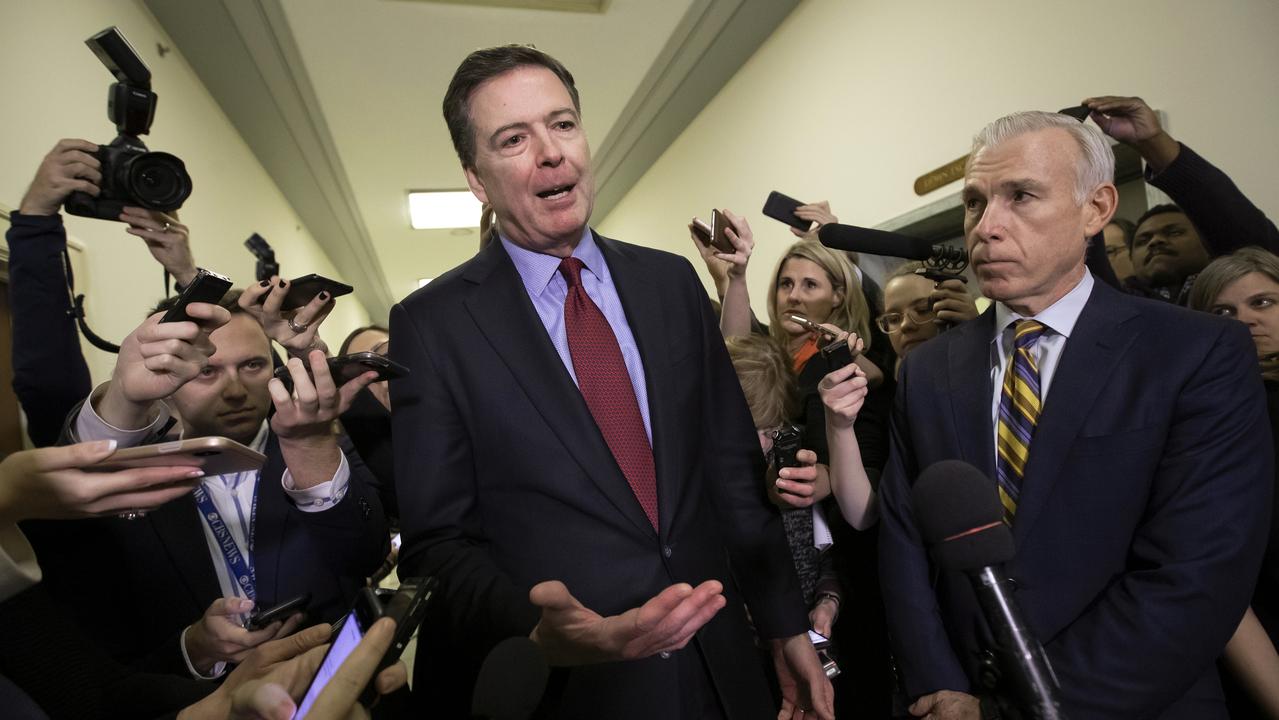Climate evangelists use lawfare to target perceived ‘offenders’
Lawfare has added a highly effective weapon to climate warriors’ arsenal.

Peter Gray is best known as the environmental activist who threw his shoes at John Howard on ABC TV’s Q&A in 2010 in a protest against the Iraq war. But his legacy goes much wider than a simple shoe toss.
In 2006, Gray won a landmark case that the government in NSW had failed to assess properly the greenhouse gas emissions from the proposed Anvil Hill coalmine. The case set a precedent and opened a new chapter in what has become one of the biggest weapons in the environmental armoury.
Gray was 26 when he launched the Anvil Hill case but died of bowel cancer five years later. He is recognised by environment groups as a pioneer of “lawfare”, in which the tactics used to defeat Big Tobacco increasingly are being applied to coal. Adani’s Carmichael coalmine project in Queensland is a textbook case of how successive legal challenges are used to grind down proponents.
The Adani project has been plagued by litigation. There have been three cases in the Federal Court for judicial review of the commonwealth approval under the Environmental Protection and Biodiversity Conservation Act. The federal minister’s initial decision had to be remade because of a technicality but complaints continued on the mine’s impact on biodiversity, particularly the endangered black-throated finch.
Environment groups failed in court but the project is again stalled after the Queensland Government sought a review of protections for the bird species.
Adani has also faced a series of cases involving native title.
And there have been a further four separate cases brought against expansion of the Abbot Point coal terminal to allow export of the large increase in coal production associated with Adani and other new mines in the Galilee Basin.
The evidence is that even if they lose in court, environmental groups consider lawfare a legitimate tactic to frustrate developments and warn off risk-averse investors. At its extreme, the lawfare push is designed to take decision-making away from governments and seek a higher authority in international courts and conventions.
As momentum builds in the courts, governments risk losing control over how they intend to meet the objectives of the Paris Agreement to combat climate change, which does not have legal force to impose anything.
As the pace and scope of lawfare accelerates around the world, the impact of stalled projects, lost opportunities and potential challenges to sovereign rights is starting to bite.
Governments are under pressure as they try to balance the competing expectations of workers, unions and companies against those of motivated, ideologically driven groups that may be based far away from where projects have been proposed. German Chancellor Angela Merkel this week raised the spectre of Russia inciting climate hysteria among German youth to further its geopolitical and strategic interests.
Analysis by legal firm Norton Rose Fulbright says more than 1154 climate change cases have been filed worldwide. About 900 of them are in the US, followed by Australia, Britain, the EU, New Zealand, Canada and Spain. According to Norton Rose, the increasing trend in climate change-related litigation represents an extra risk for business. To date most cases have not succeeded in holding companies or governments accountable for climate change. But over time, the analysis says, “strategic litigants will undoubtedly continue to develop new types of arguments and draw on new research and evidence that they claim support links between emissions harm related to climate change”.
In the Anvil Hill case, the Land and Environment Court in NSW held that the greenhouse gas emissions from the burning of the coal from the mine must be taken into account. The case set an important precedent that indirect or downstream impacts must be considered.
Gray’s legacy was refreshed in another finding in the same court this month, when chief judge Brian Preston rejected the planned Rocky Hill coking coal mine, in part because no plan had been made to offset future carbon dioxide emissions when its coal was used to make steel.
The Rocky Hill decision does not set a precedent because it relates only to that mine. But Environmental Defenders Office NSW principal David Morris says it will nonetheless have big ramifications for how future projects are considered. He calls it a “seminal moment in the development of climate litigation in Australia”, which would “weigh heavily on the minds of decision-makers”.
“Certainly the decision is of broad importance because it deals with the wrong time dilemma. If most fossil fuels should stay in the ground, why should my project go ahead? It is not a strict precedent because all decisions are on a case-by-case basis, but the wrong time decision will still be a difficult barrier to greenfields projects, particularly in NSW,” Morris says.
As a result, the judgment adds pressure to an industry facing an onslaught of court actions as green groups bypass politics to secure the objectives of the Paris Agreement to limit future global warming. Major companies are restructuring to quarantine their other activities from coal and carbon-intensive products.
Following the Rocky Hill decision, the industry is caught between attempting to downplay the ramifications and raising the alarm on sovereign risk. Behind the scenes, crisis talks are being held on how best to respond.
If there is a problem, the NSW Minerals Council has warned, the impact of the Rocky Hill decision will be felt well beyond mining. Council chief executive Stephen Galilee says there could be implications for all major emissions industries including agriculture, manufacturing and transport.
Norton Rose says the Rocky Hill decision is a landmark that significantly enhances the role of greenhouse gas emissions in the assessment of mining and other developments. After the Anvil Hill case, greenhouse gas emissions and climate change are already mandatory considerations.
Proponents of the Rocky Hill mine had sought to argue that “scope three” emissions, those released from transport and use of the coal product elsewhere, and potentially in another country, should not be considered.
But Preston determined that on environmental and public interest grounds, all emissions should be considered. He found that all of the direct and indirect emissions of the project would affect the environment and would contribute cumulatively to total global greenhouse gas emissions.
He said developed countries “such as Australia have a responsibility, including under the Climate Change Convention, the Kyoto Protocol and the Paris Agreement, to take the lead in taking mitigation measures to reduce greenhouse gas emissions”. The court agreed that further fossil fuel extraction from new sources, whether or not in Australia, will almost certainly exceed the carbon budget set by the Paris Agreement.
Before joining the bench, Preston was a principal solicitor at the Environmental Defenders Office, which took the Rocky Hill case on behalf of local residents. He has been outspoken about the need to address climate change, leading to questions about whether he should have recused himself from hearing the case. But no suggestion of apprehended bias was raised during the appeal hearing and the Supreme Court powers have come out strongly to defend Preston’s integrity.
According to Norton Rose, the judgment provides some insight into what companies can do to avoid the same fate as the Rocky Hill mine.
“The best strategy would be to incorporate emissions reduction strategies as part of the development itself to either partially reduce the GHG emissions, or completely reduce them, resulting in a carbon-neutral project,” it says. “This could be achieved by incorporating, or investing in, a ‘carbon sink’ such as a forest which removes carbon dioxide from the atmosphere. If it can be shown that the net result of the development does not adversely impact the ‘carbon budget’, it is likely that a development would not be rejected.”
For environment groups, however, the strategy is to wear down projects through protracted litigation regardless of the outcome in court. As well as frustrate specific projects, courts increasingly are being asked to force the hands of government and industry. Results to date have been mixed.
In June 2015, the district court in The Hague ordered the Dutch government to reduce its greenhouse gas emissions by at least 25 per cent by 2020 (compared with 1990 levels), the lower end of the 25 to 40 per cent target set by the UN’s Intergovernmental Panel on Climate Change.
The government appealed, arguing that the policy decision on how to reduce greenhouse gas emissions is a “political question” that should be addressed by the government, not the judiciary. It also argued the Dutch emissions, in absolute terms, were limited, that The Netherlands cannot solve the global issue of climate change alone. The Hague Court of Appeals did not agree and upheld the action taken by the Urgenda Foundation, stressing the role of courts to hold states accountable for their human rights obligations.
A similar case is slowly making its way through courts in the US, where 21 young Americans, including the granddaughter of high-profile former NASA climate scientist James Hansen, filed a lawsuit against the federal government in August 2015.
They claim the US government is violating the youngest generation’s constitutional rights to life, liberty and property by promoting the use of fossil fuels. The court is being asked to mandate a national plan to reduce atmospheric concentrations of carbon dioxide to 350 parts per million by 2100.
Last November, the Supreme Court rejected a Trump administration request to stop the lawsuit but granted permission for it to file a pre-trial appeal to test some of the most significant rulings made in planning for the trial.
One of those rulings was that the children who filed the lawsuit have a constitutional right to sue to force a government to follow policies that would provide for them a climate capable of sustaining human life.
Both the Obama and Trump administrations have argued the case was an attempt to redirect federal environmental and energy policies through the courts rather than through the political process.
US courts have so far been reluctant to get ahead of the politics. A seminal case in the US involving five US energy companies set a high bar for parties seeking to rely on common law grounds to make companies with large emission profiles reduce emissions. In an 8-0 decision, the US Supreme Court dismissed a complaint from several US state and local governments arguing the energy companies had contributed to the “nuisance” of global warming.
The findings were largely confirmed when eight cities and counties in California, along with New York City and municipalities in Colorado and Washington state, filed civil lawsuits against several oil and gas companies.
A federal judge dismissed the San Francisco and Oakland cases, saying the dangers of climate change are “very real” but that the issue should be solved by congress. A month later a federal judge dismissed New York City’s lawsuit, saying climate change should be dealt with by congress and the president, not the courts.
Environmental groups are unlikely to give up. They are now modelling their campaign on the war against tobacco, zeroing in on executives. In October, New York Solicitor-General Barbara Underwood sued Exxon, alleging a “longstanding fraudulent scheme” to deceive investors by providing false and misleading assurances that it was managing climate risk. The lawsuit said the alleged fraud reached the highest levels of Exxon, including former chairman Rex Tillerson.
Environment groups have deep pockets and little personal risk. The climate war is seeking to outflank government and has moved decisively to financial markets and the courts.




To join the conversation, please log in. Don't have an account? Register
Join the conversation, you are commenting as Logout